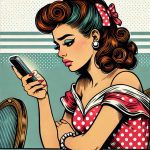
Art has always been a reflection of the times, evolving with society’s shifts and technological advancements. Today, social media is at the forefront of this transformation, altering the way we create, share, and consume art. From Instagram to TikTok, these platforms have revolutionized the art world, breaking down traditional barriers and introducing new challenges. But what does this mean for traditional art forms that have been cherished for centuries? Let’s explore how social media has reshaped the landscape of art in profound and unexpected ways.
The Rise of Social Media
Social media platforms like Facebook, Instagram, and Twitter have become integral parts of daily life. Since their inception in the early 2000s, these platforms have grown exponentially, with billions of users worldwide. This digital revolution has not only changed how we communicate but also how we engage with art. Platforms that prioritize visual content have particularly influenced the art community, providing new avenues for artists to showcase their work and reach global audiences.
The statistics are staggering. Instagram, for instance, boasts over 1 billion active users, many of whom follow art-related accounts. This widespread adoption of social media has created a virtual gallery space where artists can exhibit their work without the need for physical galleries or traditional gatekeepers. The democratization of art distribution means that artists from all corners of the world can now share their creations with a click of a button.
The connection between art and social media began subtly but has now become a driving force in the art world. Artists use these platforms not just to display their work but also to interact with their audience, receive feedback, and even collaborate with other artists. This interactivity has fostered a dynamic and participatory art culture that was previously unimaginable.
Changes in Artistic Practices
One of the most significant changes brought about by social media is the introduction of new digital tools and techniques. Artists are now using software like Photoshop, Procreate, and various other apps to create digital art that is easily shareable online. These tools have expanded the possibilities for artistic expression, allowing artists to experiment with new styles and mediums that were not possible before.
Social media has also made art creation and distribution more accessible. Artists no longer need to rely on expensive materials or studio spaces to create and share their work. With just a smartphone and an internet connection, anyone can become an artist and share their creations with the world. This accessibility has led to a surge in amateur artists who use platforms like Instagram to hone their skills and build a following.
The interactive nature of social media has also transformed how artists engage with their audiences. Traditional art forms often involved a one-way interaction where the artist created and the audience consumed. However, social media allows for real-time feedback and collaboration. Artists can engage with their followers, answer questions, and even take suggestions, creating a more dynamic and interactive artistic process.
This increased accessibility and interactivity have democratized the art world, providing a platform for emerging artists who might not have had the opportunity to showcase their work otherwise. Social media has leveled the playing field, allowing artists from diverse backgrounds to gain recognition and build careers without the need for traditional art world endorsements.
The Democratization of Art
Many artists have found success through social media, bypassing traditional gatekeepers like galleries and critics. Platforms like Instagram and TikTok offer a stage for unknown artists to gain exposure and build a following. This has led to the rise of “Instagram artists,” who have amassed large audiences and even commercial success through their online presence.
The reduction of gatekeeping in the art world has allowed for a more inclusive range of voices and styles. Artists who might have been overlooked by traditional galleries now have the chance to be seen and appreciated by a global audience. This democratization has led to a richer and more varied artistic landscape, where unique and unconventional styles can thrive.
Case studies of artists who have risen to fame through social media abound. Take the example of Rachel Ryle, an animator whose stop-motion videos gained massive popularity on Instagram. Her work, which combines traditional animation techniques with digital tools, showcases how social media can amplify an artist’s reach. Another example is Australian artist CJ Hendry, whose hyper-realistic drawings gained her a significant following and led to successful solo exhibitions.
Breaking traditional barriers has not only given artists new opportunities but also enriched the cultural tapestry of the art world. The ability to share and receive instant feedback from a global audience has empowered artists to experiment with new ideas and techniques, pushing the boundaries of what is considered traditional art.
The Transformation of Art Consumption
Social media has also transformed the way we consume art. The rise of visual culture on platforms like Instagram and TikTok has led to shorter attention spans, with users scrolling through images and videos at a rapid pace. This shift has influenced how artists create their work, often favoring eye-catching, immediate impact over slower, contemplative pieces.
Virtual exhibitions and online galleries have become more common, especially in the wake of the COVID-19 pandemic. Institutions like the Louvre and the Metropolitan Museum of Art have embraced digital platforms to reach audiences unable to visit in person. These virtual spaces offer a new way to experience art, making it accessible to anyone with an internet connection.
The influence of social media trends has also shaped artistic expression. Viral challenges, hashtags, and trending topics can quickly turn an obscure artwork into a global sensation. This phenomenon has encouraged artists to engage with current events and popular culture, creating work that resonates with a broader audience.
However, the commercialization of art through social media also presents challenges. The pressure to produce content that garners likes and shares can sometimes lead to a focus on quantity over quality. Artists may feel compelled to conform to popular trends rather than pursuing their unique vision, potentially diluting the artistic integrity of their work.
Commercialization and Monetization
Despite these challenges, social media has opened up new revenue streams for artists. Platforms like Patreon, Etsy, and even Instagram itself allow artists to monetize their work through commissions, merchandise sales, and sponsored content. This financial support can be crucial for independent artists seeking to sustain their careers.
Sponsorships and collaborations with brands and influencers have become increasingly common. Artists can partner with companies to create unique pieces, participate in marketing campaigns, or design exclusive products. These collaborations offer financial benefits and increased exposure, helping artists reach new audiences.
The rise of Non-Fungible Tokens (NFTs) has introduced a new way for artists to sell their digital work. NFTs are unique digital assets that can be bought, sold, and traded on blockchain platforms. This trend has sparked both excitement and controversy within the art world, offering artists a novel method of monetizing their digital creations while raising questions about the environmental impact and speculative nature of the NFT market.
While social media offers many opportunities for commercialization, it also raises concerns about the potential exploitation of artists. The pressure to maintain an online presence and constantly produce new content can lead to burnout and a sense of commodification. Artists must navigate these challenges while finding ways to balance their creative passions with the demands of the digital economy.
Challenges and Criticisms
The quality vs. quantity debate is a significant concern in the age of social media. The emphasis on producing content that gains quick attention can sometimes overshadow the depth and quality of the artwork. Artists may feel pressured to conform to trends and create work that appeals to the algorithm rather than pursuing their unique vision.
Mental health impacts are another critical issue. The constant need for validation through likes, shares, and comments can take a toll on an artist’s well-being. The pressure to maintain an online presence and engage with followers can lead to anxiety, stress, and burnout. It’s essential for artists to find a balance and prioritize their mental health in the digital age.
Cultural appropriation and copyright issues are also prevalent in the realm of social media. The ease of sharing and reposting content can lead to the unauthorized use of an artist’s work. Protecting intellectual property rights and ensuring proper credit is given to original creators is a significant challenge that requires ongoing attention and regulation.
Despite these challenges, many artists continue to thrive and innovate in the social media landscape. The future of traditional art forms will likely involve a hybrid approach, blending conventional techniques with digital tools and platforms. This fusion of old and new can lead to exciting developments and continued evolution in the art world.
The Future of Traditional Art Forms
As we look to the future, it’s clear that social media will continue to play a significant role in shaping the art world. Hybrid practices that combine traditional and digital techniques are becoming more common, allowing artists to explore new creative possibilities. This blending of old and new can lead to innovative and exciting developments in the art world.
The continued evolution of social media platforms will also impact how art is created, shared, and consumed. Emerging technologies such as augmented reality (AR) and virtual reality (VR) offer new ways for artists to engage with their audiences and create immersive experiences. These advancements will likely further blur the lines between traditional and digital art forms.
Traditional institutions like museums and galleries are also adapting to the digital age. Many have embraced social media and virtual exhibitions to reach broader audiences and remain relevant in an increasingly digital world. By incorporating these new technologies and platforms, traditional institutions can continue to play a vital role in preserving and promoting art.
As the art world continues to evolve, it’s essential to remember the value of traditional art forms and the rich history they represent. While social media offers new opportunities and challenges, it also provides a platform for preserving and celebrating the timeless aspects of art. By embracing both the old and the new, we can ensure that art remains a vibrant and integral part of our cultural heritage.
Conclusion
The impact of social media on traditional art forms is profound and multifaceted. From democratizing access to art to transforming how we create and consume it, social media has reshaped the art world in countless ways. While there are challenges and criticisms, the opportunities for innovation and growth are immense.
As we navigate this digital age, it’s crucial to find a balance that honors the rich traditions of art while embracing the possibilities offered by new technologies. By doing so, we can ensure that art continues to inspire, challenge, and connect us in meaningful ways.
In the words of artist and social media influencer, Shepard Fairey, “Art should be something that liberates your soul, provokes the imagination and encourages people to go further.” This sentiment captures the essence of the transformative power of art, both in the traditional sense and in the ever-evolving world of social media.




